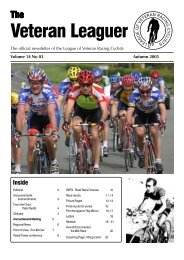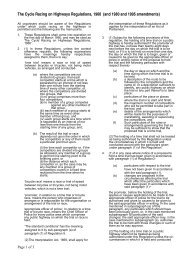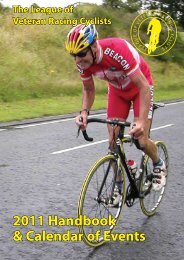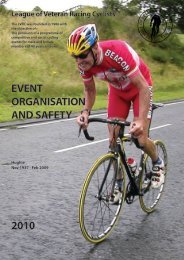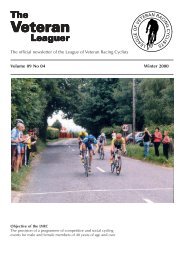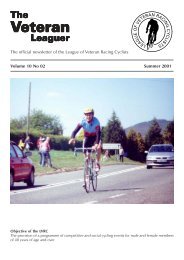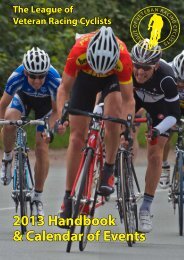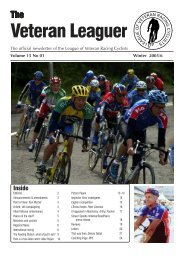Create successful ePaper yourself
Turn your PDF publications into a flip-book with our unique Google optimized e-Paper software.
Reviews<br />
French Revolutions – cycling the Tour<br />
de France: Tim Moore. Yellow Jersey<br />
Press 2001. 277 pages paperback,<br />
£12.00. ISBN 0-224-06095-3<br />
Tim Moore. Sporting status: not a<br />
couch potato. Previous experience of<br />
cycling: commuting on a Bickerton; six<br />
months on a girly bike from a stolenproperty<br />
auction; four-day MTB trip<br />
across Iceland with his brother-in-law;<br />
ten-year seasonal ob-session with the<br />
Tour de France. None of which<br />
explains a rush of blood at 36 which<br />
results in a ride round (most of) the<br />
route of the 2000 Tour, suffering pain<br />
and humiliation, but discovering the<br />
hero inside himself and being very<br />
funny on the way.<br />
There’s plenty of inventive fun:<br />
Captain Scott bewildered by his view<br />
of South Poland; the contrast between<br />
looking the part and looking a prat –<br />
not just an anagram; the excitement<br />
when a hotel proprietor identifies him<br />
as Roger Moore’s son; the ‘deeply<br />
poxy’ French breakfasts; his resort to<br />
‘manual obscenity’ when his French<br />
isn’t up to the verbal kind; ‘coq au van’<br />
as a name for a roadkill; and Bernard<br />
Hinault’s fearsome demeanour suggesting<br />
that ‘he’d been told that some<br />
bloke up the road was prancing about<br />
in a wedding dress singing, ‘Bernard,<br />
Bernard, je m’apelle Bernard.’<br />
In the interests of comedy there’s a<br />
good deal of literary licence. Charly<br />
Gaul was by no means the first cyclist<br />
to pee on the move. Percy Stannard<br />
usually spelled his name with a double<br />
L. Merckx’s cannibal year was 1969,<br />
not 70.<br />
But here are also moments of<br />
revelation, little epiphanies: ‘In<br />
conquering the savage beauty around<br />
me I have become its creator.’ Heroic<br />
legends: Eugéne Christophe, Tom<br />
Simpson. Laments: the death of the<br />
French small town as the young flee to<br />
the cities. And learning experiences:<br />
Moore is amazed to find that his<br />
intestinal agonies are down to not<br />
washing his water bottles. And did you<br />
know that 18 th May is St Eric’s Day?<br />
See. You can learn things from books.<br />
What I find remarkable is that, with his<br />
limited preparation, Moore does so<br />
well, finally achieving 280 kilometres<br />
in a (very long) day.<br />
Moore is a better writer than the<br />
much more famous Bill Bryson, and<br />
his book is immensely enjoyable.<br />
Enjoy.<br />
Ray Minovi<br />
Tour de France – the history, the<br />
legend, the riders: Graeme Fife.<br />
Mainstream Publishing, 2000. 255<br />
pages paperback, £9.99. ISBN 1-<br />
84018-284-9<br />
Based on the writer’s ‘25-year addiction<br />
to this unique event’ (half of my<br />
own), this is, says Fife, ‘an attempt to<br />
get inside the Tour’s mystique’ rather<br />
than a history. History is there, but in<br />
snapshots, or video clips, much of it<br />
well known, some of it less wellretailed,<br />
much necessarily left out. The<br />
rest recounts Fife’s own climbs of the<br />
major Alpine cols: L’Alpe d’Huez,<br />
Télégraphe, Glandon, Galibier, Izoard,<br />
Vars, while his thoughts stray to the<br />
great riders who preceded him. The<br />
accounts of what and who he’s<br />
thinking about are much better than<br />
the story of his own struggles, which<br />
are often done in a sort of writing-bynumbers,<br />
tricked out with literary<br />
quotations unnaturally transplanted.<br />
Fife is too good a writer to need these<br />
pretentious supporting devices.<br />
My heroes aren’t always the same as<br />
Fife’s. I recognise talent in any performer,<br />
but my admiration for<br />
Virenque’s attacking style is limited; I<br />
reserve my respect for those who can<br />
hack it without being fuelled by<br />
steroids and EPO. Fife almost despises<br />
Indurain (‘Lovely man; no brain’ he<br />
patronises) for husbanding his resources<br />
and playing to his strengths;<br />
but Anquetil, who did exactly the<br />
same, plus being a druggie and a<br />
cheat, gets his wholehearted admiration.<br />
Incidentally, the latter emerges as<br />
the most talented shit cycling has ever<br />
seen – perhaps the instinctive recognition<br />
of this is why the fans never took<br />
him to their hearts as they did Vietto<br />
and Poulidor.<br />
It’s an attractive book. There’s an<br />
insert of eight photos and a useful<br />
index. Georges Ronsse (not Rousse)<br />
was world champion. Big sprockets<br />
give you a smaller gear, not a larger<br />
one. Incidentally the story of Bartali<br />
searching the route for Coppi’s discarded<br />
bottle so he could find out<br />
what the campionissmo was on isn’t<br />
apocryphal – Bartali himself tells it.<br />
A few errors, but a thoroughly<br />
enjoyable book to add to your shelf of<br />
addictions.<br />
Ray Minovi<br />
The Long Distance Cyclist’s Handbook:<br />
Simon Doughty. A & C Black,<br />
2001. 216 pages paperback, £14.99.<br />
ISBN 0-7136-5819-3<br />
You may think that covering miles at<br />
below winter training pace merely for<br />
its own sake is a bit like train-spotting.<br />
But there are upsides: you do get to<br />
enjoy a lot of scenery during the<br />
daytime parts; there’s the undeniable<br />
sense of achievement; it keeps you fit;<br />
and there’s none of that aggressive,<br />
beating other people – you’re competing<br />
against yourself, the terrain, and<br />
the weather.<br />
For superannuated racing cyclists<br />
Audax is probably the most attractive<br />
alternative – stripped bike, higher<br />
speeds, any distance you want, really.<br />
Simon Doughty takes you through<br />
equipment, bike set-up, clothing, food<br />
and water, health and hygiene, safe<br />
cycling, maintenance, travelling<br />
abroad, and navigation – don’t blindly<br />
follow others who ‘seem to know<br />
where they’re going’. I wouldn’t much<br />
enjoy some of the bikes photographed,<br />
particularly the one on page 55 attached<br />
to a trailer the size of an Eddie<br />
Stobart truck, with a leather saddle<br />
pointing down at 15 degrees – not my<br />
idea of pleasure or safety. But then,<br />
leather was what we made do with<br />
while we waited for superior manmade<br />
products to come along.<br />
There’s training, from first principles<br />
to periodisation, tapering and peaking.<br />
Finally we look at training for specific<br />
events, from 200 km randonnées to<br />
the Race Across America, an event so<br />
demanding that more people have<br />
flown in outer space than have completed<br />
it. No way, Miguel, as Del Boy<br />
would say.<br />
If you can learn anything from a<br />
book, then this one gives you absolutely<br />
everything you need, and it’s<br />
always clear, lucid, no frills. Not really<br />
for would-be racing cyclists, (though<br />
they’d learn something), but the longdistance<br />
aspirant will find it not only<br />
immensely useful, but unique – I don’t<br />
know of another book that covers the<br />
subject.<br />
Ray Minovi<br />
Page 16 <strong>Veteran</strong> Leaguer: Winter 2002



